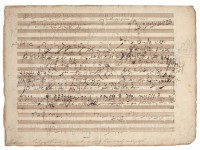An autograph sketchbook page of a composition by Ludwig van Beethoven discovered in a Greenwich, Connecticut, home has sold at auction for $120,000 including buyer’s premium. The sketchleaf was previously unknown to Beethoven scholars and is a rare intact page to survive the dismemberment and sale of Beethoven’s sketchbooks after his death.
 It was found hanging on a wall of a Greenwich woman by Brendan Ryan, an appraiser for Butterscotch Auction Gallery. A music major, composer and Beethoven fan, Ryan immediately recognized Beethoven’s handwriting. To confirm its authenticity and identify the composition, Ryan enlisted his former music history professor and mentor Dr. Carmelo Comberiati of Manhattanville College who had studied Beethoven manuscripts as a Fulbright scholar in Vienna. Comberiati identified the music as the first movement chorus, “Ruhend von seinen Thaten,” of Opus 117 or König Stephan, incidental music commissioned by Emperor Francis I of Austria for a stage production on the occasion of the opening of the new Pest Theater in Hungary. (King Stephen I was the founder of Hungary; hence the subject matter).
It was found hanging on a wall of a Greenwich woman by Brendan Ryan, an appraiser for Butterscotch Auction Gallery. A music major, composer and Beethoven fan, Ryan immediately recognized Beethoven’s handwriting. To confirm its authenticity and identify the composition, Ryan enlisted his former music history professor and mentor Dr. Carmelo Comberiati of Manhattanville College who had studied Beethoven manuscripts as a Fulbright scholar in Vienna. Comberiati identified the music as the first movement chorus, “Ruhend von seinen Thaten,” of Opus 117 or König Stephan, incidental music commissioned by Emperor Francis I of Austria for a stage production on the occasion of the opening of the new Pest Theater in Hungary. (King Stephen I was the founder of Hungary; hence the subject matter).
Beethoven received the commission in the summer of 1811 while he was taking the waters in the Bohemian spa town of Teplitz. He had fallen ill in the spring, plagued with migraines and a high fever, and went to Teplitz on his doctor’s advice. He was there for six weeks. It took him just two of those weeks to compose the music for König Stephan.
Beethoven’s composition process is beautifully illustrated in the chaotic activity on the page. He first wrote down all his ideas and then streamlined them into the finished work.
An expert on historical musical manuscripts at the University of Pennsylvania, Professor Jeffrey Kallberg, said it was an important and exciting discovery.
“Beethoven manuscripts turn up on the auction market with some regularity, but usually they’re known manuscripts. What makes this particularly interesting is this hadn’t garnered any notice — it’s been in this private collection,” said Kallberg, who viewed the piece on-line from his office in Philadelphia. “It’s a new manuscript, or a page from a manuscript, so that’s pretty exciting.”
It also captures quintessential Beethoven.
“He was famous for his sketching, and he sketched copiously. And it’s the archetypical looking Beethoven sketch — he had God-awful handwriting, he was working fast, it has the look of a messy genius.”
Pages from this sketchbook come in a variety of sizes and types because Beethoven made the sketchbook himself by sewing together whatever paper he had lying around with a needle and twine. They are identifiable as part of the same book because they all have the same three stitch holes on the side which is how scholars are able to connect the individual leaves that were sold off and scattered after his death. Four other complete pages from the sketchbook are now in the collection of Beethoven-Haus in Bonn (one, two, three, four). Other known pages survive only as fragments that were cut up by dealers and sold to tourists and fans.
This particular page made its way across the Atlantic Ocean in 1886 when William Künzel of Leipzig, Germany, sold it to Fred M. Steele, a prominent Chicago lawyer and autograph collector. The Steele autograph collection was auctioned off after the death his widow Ella in 1918, but it seems the sketchleaf was sold before that, in around 1915, to the seller’s ancestors in Greenwich. It’s been in the family for a hundred years. The new owner is a leading German antiques dealer, so it looks like the sketchleaf will be heading home.